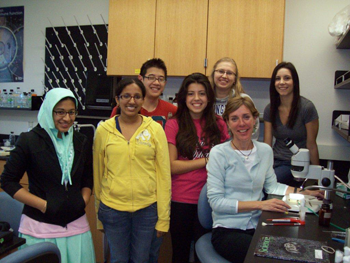Profiles in research: Amanda Norvell
A decade after the fruit fly’s genome was sequenced, biologist Amanda Norvell is zeroing in on the specific roles that certain genes play within a fly’s egg cells.

Amanda Norvell (seated) and research students

Biologist Amanda Norvell spends hours in the laboratory each week peering through the lens of a powerful microscope at a tiny organism, the fruit fly. What she can see inside it is tinier still and quite amazing: individual protein molecules moving around inside the fly’s egg cells.
A decade after the fruit fly’s genome was sequenced, Norvell is zeroing in on the specific roles that some of the now identified genes play within these cells.
“I use the process of fruit fly oogenesis—egg production—to understand how cells set up internal asymmetries,” she says, referring to the unequal, but intentional distribution of a cell’s internal contents. “What I’m particularly interested in is a protein called Gurken, which is named for the pickle-shaped eggs produced by mothers with defective Gurken genes. My lab studies how this protein ends up at the right place on one side of the cell, at the right time, in oogenesis.”
The processes that begin with the replication of information in DNA and result in protein production—transcription and translation, respectively—have profound implications not just for the life of the cell, but for the organism itself.
“In normal cells, these processes must occur with great accuracy, as defects in a cell’s DNA or in transmitting the genetic information into proteins can lead to deregulated cell growth, which is a hallmark of cancer cells,” says Norvell, whose post-doctorate fellowship at Princeton University was funded by the American Cancer Society. “Investigators can study these normal cellular processes in the simple and easily manipulated fly, and then translate their findings to help understand what happens in more complex systems, such as human cells.”
She notes that in her field, “there has been a lot of attention paid to transcription, but less to translation, and that’s what I focus on.” Her lab examines the females flies, for example, that do not make Gurken protein—used in both the set-up of the egg and the embryo—and end up being sterile, as their eggs cannot support developing embryos.
“Asymmetry matters. It’s what allows neuron cells, for example, to transmit signals on one side and receive on the other,” says Norvell, who clearly relishes the fundamentals of cellular organization, or science at its most basic.
Her enthusiasm is infectious. She works with students in the lab during the school year and over the summer, engaging them in such tasks as isolating the ovaries of mutant flies and performing experiments on their RNA to study the impacts on fertility. Norvell said she knew early on in her academic career that she wanted to end up at a smaller, teaching-centered college.
‘”There is such excitement in discovering something new,” she notes of her undergraduate research assistants, adding that the lure of the lab has prompted several of her pre-med students to enter joint MD–PhD programs in graduate school.
Norvell’s fondness for her research also extends to her laboratory subject, the fruit fly, known in scientific circles as Drosophila melanogaster, Greek for “dark-bellied dew lover.”
“Flies are great. There is so much molecular biology you can do with them,” says Norvell, eagerly observing, for example, how easily their “asymmetry is disrupted.”
This summer, she received a batch of mutant flies from scientists in France that, alas, “cooked on the way over” in an extended heat wave. But her disappointment was short-lived. She simply asked for more.
“In our community, you can just call up another researcher and say you’re interested in receiving some flies,” she said. “The fly community is a tight one.”
Posted on November 3, 2011

